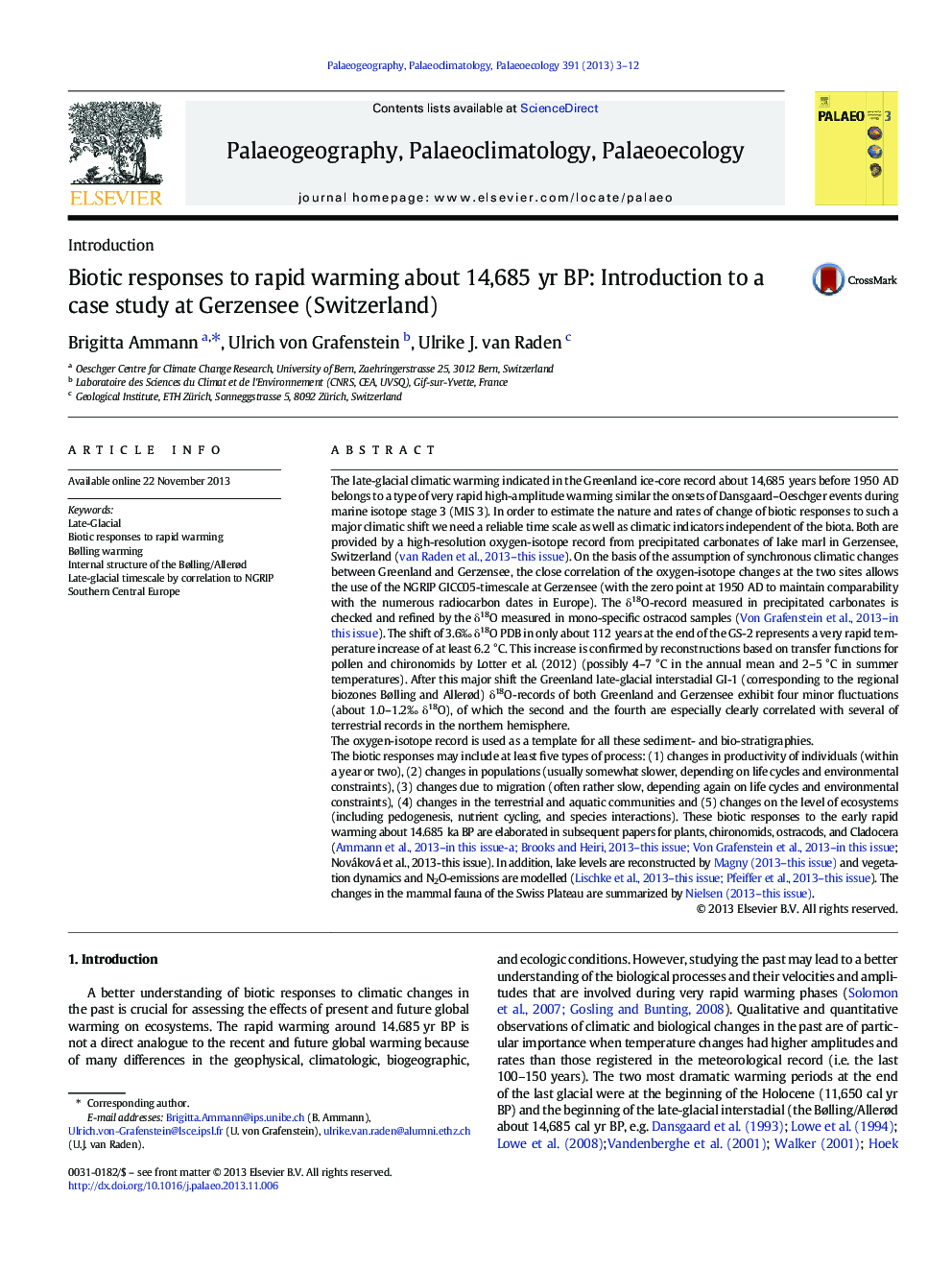| Article ID | Journal | Published Year | Pages | File Type |
|---|---|---|---|---|
| 6350152 | Palaeogeography, Palaeoclimatology, Palaeoecology | 2013 | 10 Pages |
â¢This introduction provides a concept to study biotic responses to climatic change.â¢The onset of Bølling was a rapid warming of high amplitude.â¢At identical levels isotope- and biostratigraphies were studied on a single core.â¢The oxygen-isotope record provides both an estimate of temperature and a chronology.â¢Terrestrial and aquatic organisms responded as populations and ecosystems.
The late-glacial climatic warming indicated in the Greenland ice-core record about 14,685 years before 1950 AD belongs to a type of very rapid high-amplitude warming similar the onsets of Dansgaard-Oeschger events during marine isotope stage 3 (MIS 3). In order to estimate the nature and rates of change of biotic responses to such a major climatic shift we need a reliable time scale as well as climatic indicators independent of the biota. Both are provided by a high-resolution oxygen-isotope record from precipitated carbonates of lake marl in Gerzensee, Switzerland (van Raden et al., 2013--this issue). On the basis of the assumption of synchronous climatic changes between Greenland and Gerzensee, the close correlation of the oxygen-isotope changes at the two sites allows the use of the NGRIP GICC05-timescale at Gerzensee (with the zero point at 1950 AD to maintain comparability with the numerous radiocarbon dates in Europe). The δ18O-record measured in precipitated carbonates is checked and refined by the δ18O measured in mono-specific ostracod samples (Von Grafenstein et al., 2013--in this issue). The shift of 3.6Ⱐδ18O PDB in only about 112 years at the end of the GS-2 represents a very rapid temperature increase of at least 6.2 °C. This increase is confirmed by reconstructions based on transfer functions for pollen and chironomids by Lotter et al. (2012) (possibly 4-7 °C in the annual mean and 2-5 °C in summer temperatures). After this major shift the Greenland late-glacial interstadial GI-1 (corresponding to the regional biozones Bølling and Allerød) δ18O-records of both Greenland and Gerzensee exhibit four minor fluctuations (about 1.0-1.2Ⱐδ18O), of which the second and the fourth are especially clearly correlated with several of terrestrial records in the northern hemisphere.The oxygen-isotope record is used as a template for all these sediment- and bio-stratigraphies.The biotic responses may include at least five types of process: (1) changes in productivity of individuals (within a year or two), (2) changes in populations (usually somewhat slower, depending on life cycles and environmental constraints), (3) changes due to migration (often rather slow, depending again on life cycles and environmental constraints), (4) changes in the terrestrial and aquatic communities and (5) changes on the level of ecosystems (including pedogenesis, nutrient cycling, and species interactions). These biotic responses to the early rapid warming about 14.685 ka BP are elaborated in subsequent papers for plants, chironomids, ostracods, and Cladocera (Ammann et al., 2013--in this issue-a; Brooks and Heiri, 2013--this issue; Von Grafenstein et al., 2013--in this issue; Nováková et al., 2013-this issue). In addition, lake levels are reconstructed by Magny (2013--this issue) and vegetation dynamics and N2O-emissions are modelled (Lischke et al., 2013--this issue; Pfeiffer et al., 2013--this issue). The changes in the mammal fauna of the Swiss Plateau are summarized by Nielsen (2013--this issue).
